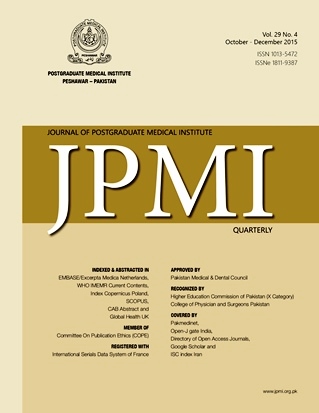THE ASSOCIATION BETWEEN METABOLIC SYNDROME AND SERUM LEVELS OF MALONDIALDEHYDE AND INTERLEUKIN -6 IN GORGAN
Main Article Content
Abstract
Objective: There are limited studies on the relationship between inflamma -tory marker such as IL-6 and lipid peroxidation and metabolic syndrome. The
aim of present study was to assess IL-6 and lipid peroxidation in subjects with
and without the metabolic syndrome and their association with metabolic
syndrome components.
Methodology: Age and gender matched 40 subjects with metabolic syn -drome and 40 control groups took part in this study.
Results: The mean malondialdehyde level was significantly higher in over -weight and obese subjects with metabolic syndrome than control groups
(P<0.05). The mean level of IL-6 in men and the mean level of malondialde -hyde in women with metabolic syndrome was significantly higher than con-trol groups (p < 0.05). There were significant positive correlation between
malondialdehyde and fasting blood glucose, triglyceride and systolic blood
pressure (p<0.05).
Conclusion: Our results suggest that higher levels of IL-6 and malondialde-hyde may cause insulin resistance and metabolic disorders in all subjects with
metabolic syndrome. Malondialdehyde level shows strong association with
some metabolic syndrome components. This means the greater risk of met -abolic syndrome.
aim of present study was to assess IL-6 and lipid peroxidation in subjects with
and without the metabolic syndrome and their association with metabolic
syndrome components.
Methodology: Age and gender matched 40 subjects with metabolic syn -drome and 40 control groups took part in this study.
Results: The mean malondialdehyde level was significantly higher in over -weight and obese subjects with metabolic syndrome than control groups
(P<0.05). The mean level of IL-6 in men and the mean level of malondialde -hyde in women with metabolic syndrome was significantly higher than con-trol groups (p < 0.05). There were significant positive correlation between
malondialdehyde and fasting blood glucose, triglyceride and systolic blood
pressure (p<0.05).
Conclusion: Our results suggest that higher levels of IL-6 and malondialde-hyde may cause insulin resistance and metabolic disorders in all subjects with
metabolic syndrome. Malondialdehyde level shows strong association with
some metabolic syndrome components. This means the greater risk of met -abolic syndrome.
Article Details
How to Cite
1.
Sarbijani HM, Khoshnia M, Marjani A. THE ASSOCIATION BETWEEN METABOLIC SYNDROME AND SERUM LEVELS OF MALONDIALDEHYDE AND INTERLEUKIN -6 IN GORGAN. J Postgrad Med Inst [Internet]. 2016 Jan. 3 [cited 2025 Dec. 5];29(4). Available from: https://jpmi.org.pk/index.php/jpmi/article/view/1763
Issue
Section
Original Article
Work published in JPMI is licensed under a
Creative Commons Attribution-NonCommercial 2.0 Generic License.
Authors are permitted and encouraged to post their work online (e.g., in institutional repositories or on their website) prior to and during the submission process, as it can lead to productive exchanges, as well as earlier and greater citation of published work.


